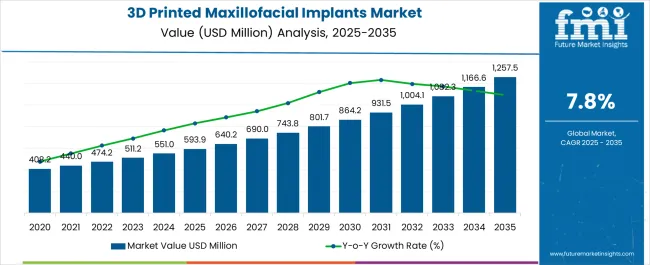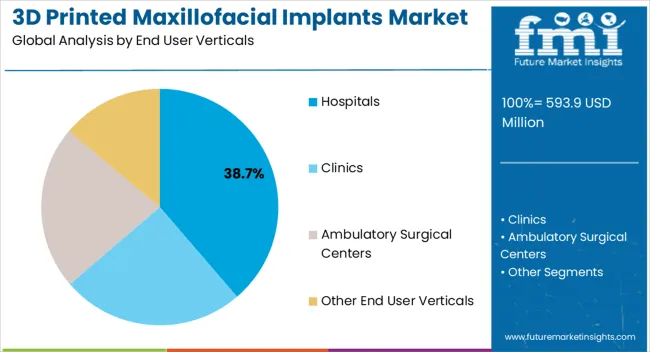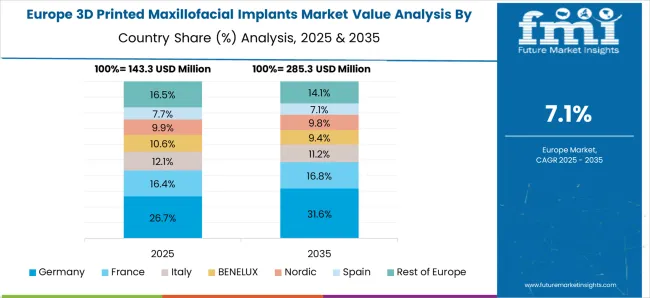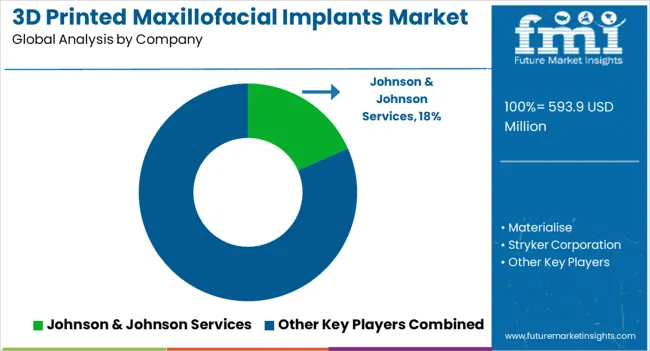The 3D Printed Maxillofacial Implants Market is estimated to be valued at USD 593.9 million in 2025 and is projected to reach USD 1257.5 million by 2035, registering a compound annual growth rate (CAGR) of 7.8% over the forecast period.

| Metric | Value |
|---|---|
| 3D Printed Maxillofacial Implants Market Estimated Value in (2025 E) | USD 593.9 million |
| 3D Printed Maxillofacial Implants Market Forecast Value in (2035 F) | USD 1257.5 million |
| Forecast CAGR (2025 to 2035) | 7.8% |
The 3D printed maxillofacial implants market is experiencing notable expansion as advancements in additive manufacturing and biomaterials converge with the growing demand for personalized healthcare solutions. Hospitals and surgical centers are increasingly adopting 3D printing for patient specific implants that improve surgical precision, reduce operating time, and enhance recovery outcomes.
Regulatory support for biocompatible materials and the growing acceptance of digital surgical planning are accelerating integration across healthcare systems. Rising incidences of trauma cases, congenital deformities, and complex reconstructive surgeries have further reinforced the adoption of 3D printed maxillofacial implants.
Continuous innovations in printing accuracy and the ability to produce complex geometries are enabling clinicians to achieve better patient specific outcomes. The market outlook remains strong as hospitals and specialty clinics continue to embrace 3D printing technology to deliver efficient, cost effective, and customized solutions aligned with modern medical advancements.

The hospitals segment is projected to account for 38.70% of total market revenue by 2025 within the end user verticals category, making it the leading segment. This dominance is being driven by the higher patient inflow, advanced infrastructure, and the availability of skilled surgical teams in hospitals that enable the adoption of 3D printed solutions at scale.
Hospitals are prioritizing patient specific implants to enhance surgical success rates, reduce complication risks, and optimize long term recovery outcomes. Moreover, strategic collaborations between hospitals, research institutes, and medical device manufacturers are accelerating clinical integration and expanding access to cutting edge 3D printing technologies.
With their central role in complex surgeries and ability to invest in advanced surgical innovations, hospitals continue to dominate the market for 3D printed maxillofacial implants.
Growing Prevalence of Facial Injuries to Boost the Demand for 3D Printed Maxillofacial Implants
As per the Centers for Disease Control and Prevention (CDC), 1.7 to 408.2 million traumatic brain injuries are reported annually in the United States. Out of these, 10% arise due to sports and recreational activities. In 2020, the United States Consumer Product Safety Commission (CPSC) data revealed that 454,407 sports-related head injuries were treated in the United States. Such facts and figures are expected to widen the scope of 3D-printed maxillofacial implant growth during the forecast period.
The growing prevalence of facial injuries and fractures is anticipated to drive the demand for maxillofacial implant equipment in the forthcoming years. Some of the most vital factors driving the incidence of facial fractures include incidents such as domestic accidents, motor vehicle accidents, violence, work-related injuries, and sports, among others. Among all, road traffic accidents are likely to secure a dominant share of maxillofacial trauma events.
Growing Approvals by Regulatory Authorities to Pose Significant Opportunities to the 3D-Printed Maxillofacial Implants Market
Increasing approvals of the equipment by authorities such as the FDA is expected to offer significant opportunities for expansion during the forecast period. For instance, In July 2025, a 3D printed bone graft from medical equipment manufacturer Cerhum obtained approval for use in Europe.
MyBone is the first commercially available 3D printed bone graft authorized under the Medical Device Regulation 2020/745 and has also been ISO 13485 certified. As a result, the patient-specific bone graft will now be made available to maxillofacial and orthopedic surgeons throughout the continent. Such factors are likely to strengthen the 3D printed maxillofacial implants market during the forecast period.
Lack of Awareness to Limit the 3D Printed Maxillofacial Implants Market
Lack of awareness about the market is expected to act as a significant factor limiting the market growth during the forecast period. Further, high expenses associated with a 3D printed maxillofacial implant are another cause hindering the development of the market in the assessment period.
Growing technological development in maxillofacial implants is expected to act as a significant counter to the hampering factors and assist in market growth during the forecast period.
Maximum Benefits Offered by Healthcare Settings to Strengthen the Hospital Segment
The study reveals that the hospital segment is likely to dominate the global 3D printed maxillofacial implants market during the forecast period. In 2024, the segment garnered at USD 822.5 million.
Domination of the segment can be attributed to the fact that maximum maxillofacial surgeries are conducted in hospitals due to the presence of technologically developed equipment, facilities, and expertise in these healthcare settings.
Other provisions like intensive care units and post-surgical support might lead to many people going to hospitals. Thus, due to various benefits provided by these healthcare settings, the hospital segment is going to exhibit various prospects of growth in the forecast period.
| Category | By End User Vertical |
|---|---|
| Top Segment | Hospital |
| Market Share in Percentage | 73.3% |
Growing Approvals by FDA for Key Equipment to widen Market Growth Prospects
According to FMI’s analysis, North America is anticipated to dominate the global market during the forecast period. In 2025, the region claimed 37.4% of the total market share. The United States is anticipated to make the maximum contribution to developing the regional market.
Expansion of the regional market is majorly attributed to the expanding geriatric population along with the presence of renowned international players in the region. Also, the number of surgeries performed in the United States is high and is multiplying each year which is projected to have a positive impact on the market during the forecast period.
Growing approval by the United States FDA for key 3D printed maxillofacial equipment is anticipated to fuel the market growth in the forecast period. In October 2024, Pioneering 3D printer manufacturer 3D Systems announced that it received 510(k) clearance from the FDA to 3D print maxillofacial surgical guides using its LaserForm Ti and DuraFormProX PA materials. Such factors are expected to make significant contributions to the market growth in the forecast period.
| Regional Market Comparison | Global Market Share in Percentage |
|---|---|
| North America | 37.2% |
| Europe | 28.4% |
Introduction of New Products in Europe’s Market to Develop the Regional Market

According to Future Market Insights, Europe’s 3D printed maxillofacial implants market is anticipated to be the second-largest market during the forecast period. In 2025, the region secured 29.2% of the global market share.
Expansion of the regional market can be attributed to the growing launch of new products in the market. For instance, in 2020, Evonik rolled out new radiopaque material, PEEK, which can be used for implant technology. The newly launched material can be used in maxillofacial implants. It also offers enhanced bio-stability and biocompatibility.
| Regional Market Comparison | Global Market Share in Percentage |
|---|---|
| The United States | 34.7% |
| Germany | 7.3% |
| Japan | 4.6% |
Ongoing Research and Development in the Field to Drive Asia Pacific’s 3D Printed Maxillofacial Implants Market
Asia Pacific is projected to be the most significant market during the forecast period, expected to display a CAGR of 7.7% until 2035. This can be attributed to the presence of untapped market opportunities in the region. Developing countries like India, China, Japan, and others, are likely to hold significant market opportunities in the region.
Ongoing research and development in developing countries of the region is expected to develop the market in the coming time. For instance,
| Regional Markets | CAGR (2025 to 2035) |
|---|---|
| The United Kingdom | 7% |
| China | 9.1% |
| India | 7.9% |
| Australia | 6.3% |
Ongoing research and development in the 3D printed maxillofacial implants is expected to encourage new players to enter the market, thus, augmenting the market size notably. Some of the names gaining popularity include Maxillofacial Implants (India), Avay (India), Seinser Implants (India), Nasseo (USA), Keystone Dental (2006), iDentical (USA), 3di GmbH (Germany), BioMaterals Korea, Inc. (Korea), Zoriox Innovation Labs (India), and others. Emerging players in the market are making notable contributions to developing the market. For instance,

Key players in the global 3D printed maxillofacial implants market include Materialise, Zimmer Biomet, Medartis, DePuySynthes, and others.
Recent Industry Updates include:
| Report Attributes | Details |
|---|---|
| Growth Rate (2025 to 2035) | 7.8% CAGR |
| Market Value in 2025 | USD 507.3 million |
| Market Value in 2035 | USD 1,119.1 million |
| Base Year for Estimation | 2025 |
| Historical Data | 2020 to 2025 |
| Forecast Period | 2025 to 2035 |
| Quantitative Units | USD million or USD billion for Value |
| Report Coverage | Revenue Forecast, Volume Forecast, Company Ranking, Competitive Landscape, Growth Factors, Trends, and Pricing Analysis |
| Segments Covered | By End User Verticals, By Region |
| Regions Covered | North America; Latin America; Europe; Asia Pacific; The Middle East & Africa |
| Key Countries Profiled | The United States, Canada, Mexico, Brazil, Germany, The United Kingdom, France, Spain, Italy, Russia, China, Japan, India, South Korea, Australia, South Africa, Saudi Arabia |
| Key Companies Profiled | Johnson & Johnson Services; Materialise; Stryker Corporation; Zimmer Biomet Holdings; B. Braun Melsungen; Medtronic Plc.; Boston Medical Products; Integra Lifesciences; KLS Martin; Medartis |
| Customization Scope | Available upon Request |
The global 3D printed maxillofacial implants market is estimated to be valued at USD 593.9 million in 2025.
The market size for the 3D printed maxillofacial implants market is projected to reach USD 1,257.5 million by 2035.
The 3D printed maxillofacial implants market is expected to grow at a 7.8% CAGR between 2025 and 2035.
The key product types in 3D printed maxillofacial implants market are hospitals, clinics, ambulatory surgical centers and other end user verticals.
In terms of , segment to command 0.0% share in the 3D printed maxillofacial implants market in 2025.






Our Research Products

The "Full Research Suite" delivers actionable market intel, deep dives on markets or technologies, so clients act faster, cut risk, and unlock growth.

The Leaderboard benchmarks and ranks top vendors, classifying them as Established Leaders, Leading Challengers, or Disruptors & Challengers.

Locates where complements amplify value and substitutes erode it, forecasting net impact by horizon

We deliver granular, decision-grade intel: market sizing, 5-year forecasts, pricing, adoption, usage, revenue, and operational KPIs—plus competitor tracking, regulation, and value chains—across 60 countries broadly.

Spot the shifts before they hit your P&L. We track inflection points, adoption curves, pricing moves, and ecosystem plays to show where demand is heading, why it is changing, and what to do next across high-growth markets and disruptive tech

Real-time reads of user behavior. We track shifting priorities, perceptions of today’s and next-gen services, and provider experience, then pace how fast tech moves from trial to adoption, blending buyer, consumer, and channel inputs with social signals (#WhySwitch, #UX).

Partner with our analyst team to build a custom report designed around your business priorities. From analysing market trends to assessing competitors or crafting bespoke datasets, we tailor insights to your needs.
Supplier Intelligence
Discovery & Profiling
Capacity & Footprint
Performance & Risk
Compliance & Governance
Commercial Readiness
Who Supplies Whom
Scorecards & Shortlists
Playbooks & Docs
Category Intelligence
Definition & Scope
Demand & Use Cases
Cost Drivers
Market Structure
Supply Chain Map
Trade & Policy
Operating Norms
Deliverables
Buyer Intelligence
Account Basics
Spend & Scope
Procurement Model
Vendor Requirements
Terms & Policies
Entry Strategy
Pain Points & Triggers
Outputs
Pricing Analysis
Benchmarks
Trends
Should-Cost
Indexation
Landed Cost
Commercial Terms
Deliverables
Brand Analysis
Positioning & Value Prop
Share & Presence
Customer Evidence
Go-to-Market
Digital & Reputation
Compliance & Trust
KPIs & Gaps
Outputs
Full Research Suite comprises of:
Market outlook & trends analysis
Interviews & case studies
Strategic recommendations
Vendor profiles & capabilities analysis
5-year forecasts
8 regions and 60+ country-level data splits
Market segment data splits
12 months of continuous data updates
DELIVERED AS:
PDF EXCEL ONLINE
3D Printed Medical Implants Market Size and Share Forecast Outlook 2025 to 2035
3D-Printed Prosthetic Implants Market Size and Share Forecast Outlook 2025 to 2035
3D Printed Hip and Knee Implants Market Size and Share Forecast Outlook 2025 to 2035
3D Printed Dental Brace Market Size and Share Forecast Outlook 2025 to 2035
3D-Printed Personalized Masks Market Size and Share Forecast Outlook 2025 to 2035
3D Printed Packaging Market Size and Share Forecast Outlook 2025 to 2035
3D Printed Clear Dental Aligners Market Size and Share Forecast Outlook 2025 to 2035
3d-Printed Skincare Market Analysis - Size and Share Forecast Outlook 2025 to 2035
3D Printed Packaging Kit Market Analysis Size and Share Forecast Outlook 2025 to 2035
3D Printed Prosthetics Market Size and Share Forecast Outlook 2025 to 2035
3D Printed Surgical Models Market Analysis - Size, Share, and Forecast 2025 to 2035
3D Printed Wearable Market - by Product Type, Material Type, Technology, Sales Channel, End-User, Application, and Region - Trends, Growth & Forecast 2025 to 2035
3D Printed Medical Devices Market is segmented by drug type, treatment and distribution channel from 2025 to 2035
Market Share Breakdown of 3D Printed Packaging Manufacturers
Market Share Breakdown of 3D-Printed Stickers & Labels Manufacturers
3D Printed Drugs Market Outlook – Growth, Demand & Forecast 2025-2035
3D-Printed Stickers & Labels Market Growth – Trends & Forecast 2024-2034
3D Printed Brain Model Market Analysis – Trends & Forecast 2024-2034
3D Bioprinted Organ Transplants Market Size and Share Forecast Outlook 2025 to 2035
3D Bioprinted Human Tissue Market Analysis - Size, Share, and Forecast 2025 to 2035

Thank you!
You will receive an email from our Business Development Manager. Please be sure to check your SPAM/JUNK folder too.
Chat With
MaRIA